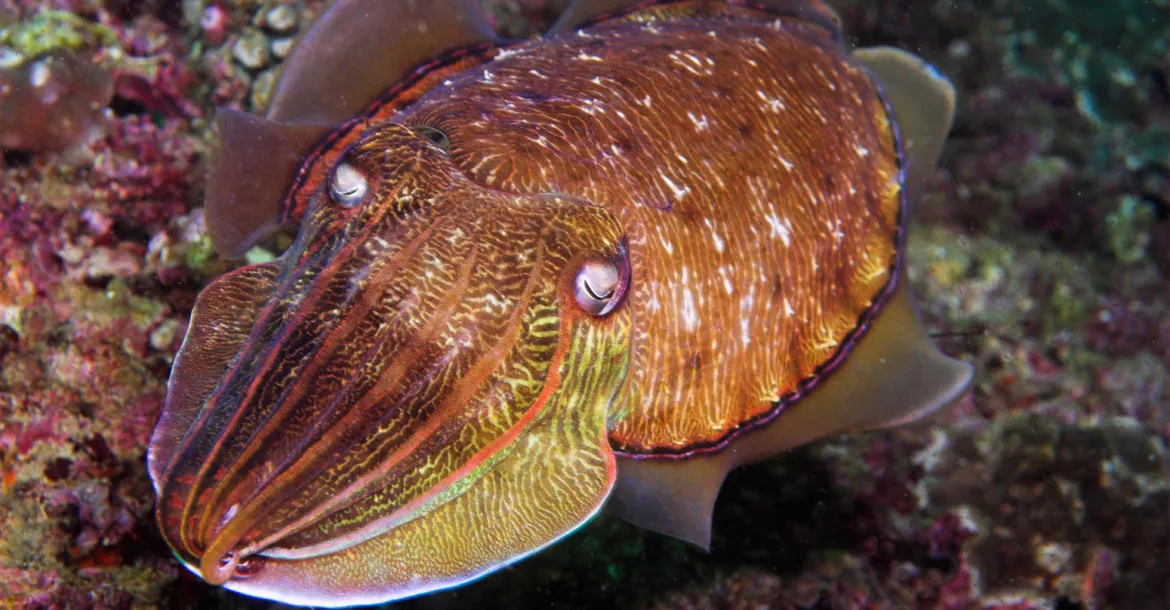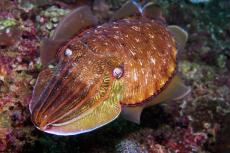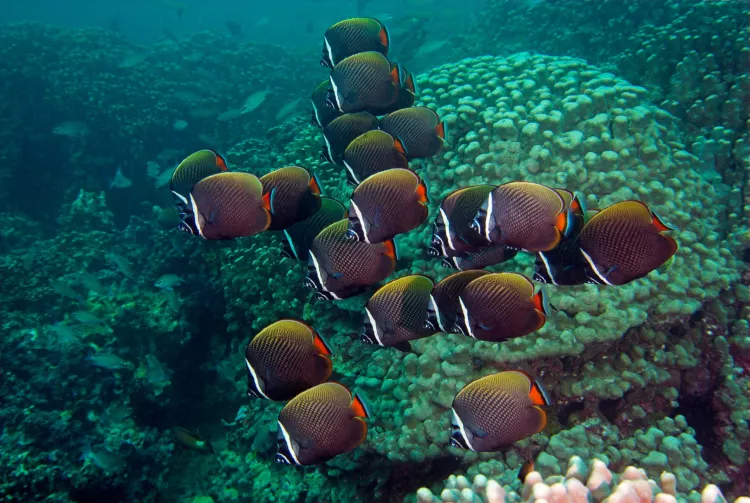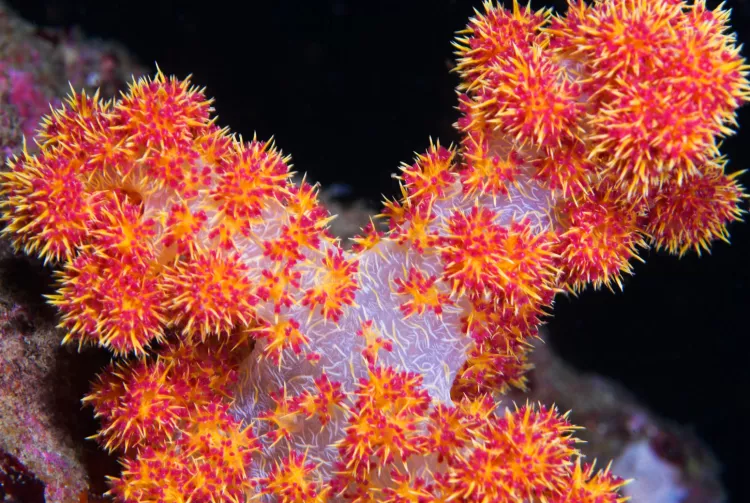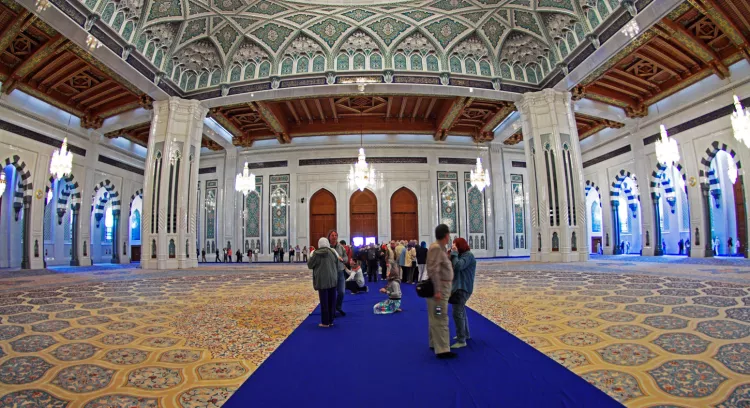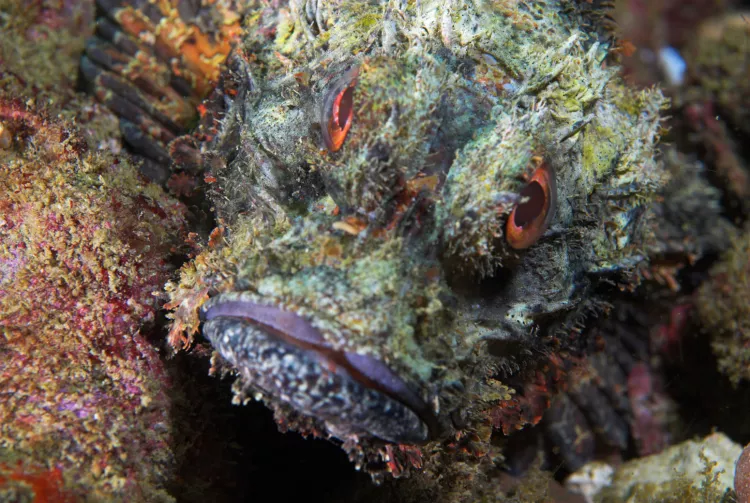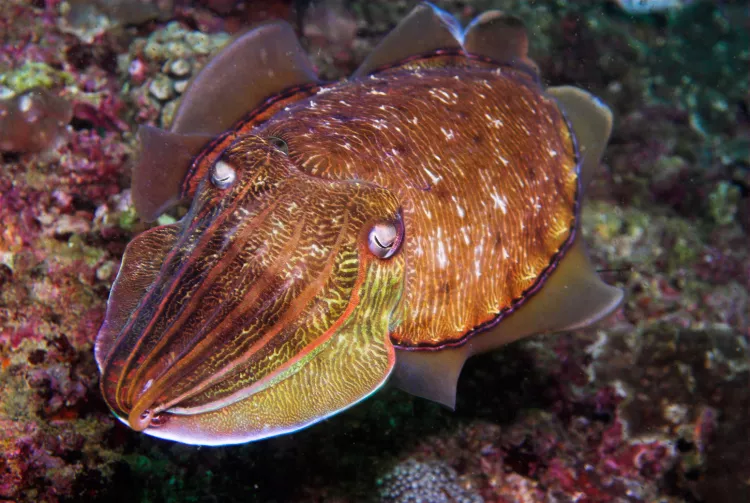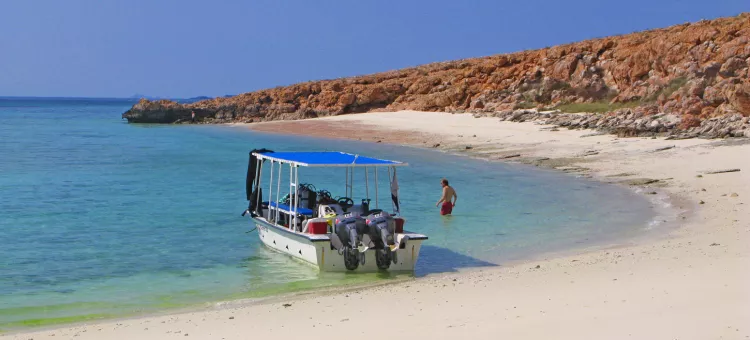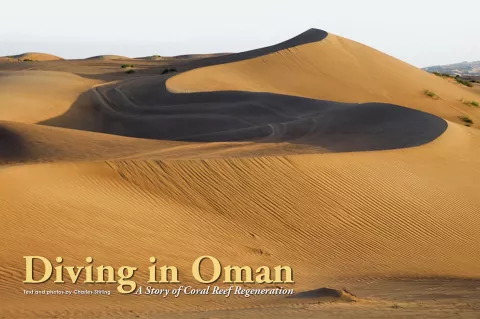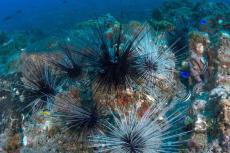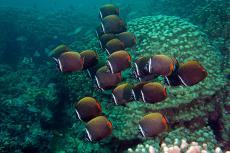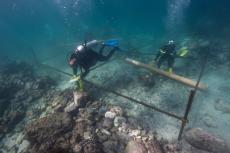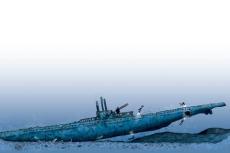I went to Oman to look at coral reefs that are regenerating from damage caused by cyclone Gonu in June 2007. Divers are just beginning to learn of the Sultanate of Oman; it’s becoming yet another destination to consider. A country with a 1700km coastline extending from the border with the Republic of Yemen in the south to the Strait of Hormuz in the north. Its shores are lapped by three seas—the Arabian Sea, Sea of Oman and the Arabian Gulf— all within latitudes where coral reefs are expected. So what are you going to find if you visit?
Contributed by
I went to Oman to look at coral reefs that are regenerating from damage caused by cyclone Gonu in June 2007. Divers are just beginning to learn of the Sultanate of Oman; it’s becoming yet another destination to consider.
A country with a 1700km coastline extending from the border with the Republic of Yemen in the south to the Strait of Hormuz in the north. Its shores are lapped by three seas—the Arabian Sea, Sea of Oman and the Arabian Gulf— all within latitudes where coral reefs are expected. So what are you going to find if you visit?
Reef building corals normally need fairly specific conditions to survive: temperatures 22°C to 29°C, clear water, hard substrate to attach to, and low nutrient water. Then they need maintenance of the right biological diversity. Oman has four distinct areas that allow reef building.
Much of its coastline is sand so does not provide the hard substrate. In the regions which have the hard substrates, it’s a country which challenges some of the perceived concepts over the requirements.
This, in itself, should make the diving of interest to the scientifically inclined coral biologists, but will be of lesser interest to the ordinary diver who is generally more interested in simply good dives.
In the far north west off the Musandam region in the Strait of Hormuz, most dives seem to be conducted off liveaboard boats, often out of the United Arab Emirates but also out of Daba. The attraction is the rough mountainous coastline with narrow fjord like bays.
This area of Oman is separated from the rest of the country by the UAE, which completely surrounds it—an exclave. I’ve heard that it’s enjoyable as a dive trip with at least reasonable coral and good fish life, but haven’t visited.
Hundreds of kilometres down the coast is the Daymaniyat-Muscat region with the Daymaniyat Islands my prime site of interest, and Muscat area a close second. This region is the most popular destination, which effectively splits into the two sub areas.
The Daymaniyats are tiny, isolated islands, about 20 km off the coast from Al Sawadi, an hour’s drive north of the capital city of Muscat. This distance limits boats visiting from the far side of Muscat to exceptionally fine days, and most will use Al Sawadi Beach Resort or the centres near the closer outskirts of Muscat. The islands are a marine reserve, established in 1996, consisting of a nine-island archipelago with many submerged rock pinnacles.
In the Muscat area coral reefs, a couple of small wrecks and the artificial reef created by the deliberate sinking of the 84m-long, 2991-ton landing craft, wreck of the Al Munassir, welcome the diver. This is rated second to the Daymaniyat Islands, and normally it should be possible to combine the two on a single week’s trip, which I was unable to do as rather strong winds stopped all diving activity during my allocated time for Muscat.
Moving on down the coast, the diving infrastructure simply hasn’t yet been well established, though corals are found in the Jazirat Masirah island and surrounding waters. Much further south, around Salalah and Sadah and the Hallaniyat islands, diving sounds possible, but it’s almost virgin territory. Salalah is probably the best bet; an airport has recently been opened, and the diving is reported as very good.
There are wrecks in the area, including the “City of Winchester” the first casualty of WWI, a 19th century one and others.
The cooler water during the monsoons is nutrient rich along with temperatures below coral growth normal limits but almost uniquely in the world here it doesn’t kill the coral. Coral here will gain an algae covering for a few months but survive to continue growing after. The diving operators seem few, maybe one at the Salalah Hilton maybe one at the Al Jabal Hotel.
Diving the Daymaniyats
I went out of the expected diving season, January early February, with the primary objective to see the regeneration in corals which was reported as unusual. Some specific shallower reef areas on some of the islands had been scrubbed virtually clean down to bare rock by backwash from the extremely high surge waves generated by cyclone Gonu.
Other areas with extensive table corals had many of them ripped from the substrate, washed into piles or broken up. This was evident on beaches all along the coast with a tideline of newly deposited coral debris, particularly from table but also small brain, pillow and fungi corals.
This is a natural phenomenon that must have been happening in this region for thousands of years when the occasional strong cyclone hits every 30 to 60 years. It’s one aspect of beach and land development.
Underwater it was exciting to see how quickly recovery had started. I wasn’t doing sampling or measurements, just acting as an inquisitive diver, but the scrubbed rock looked to be gaining a covering of coraline algae, bryozoans and small soft and hard corals.
The surprises came with the table coral, upturned and maybe in a pile, sending new branches up from what had been the undersides. In Hawaii some damaged table corals have experimentally been turned right side up by divers and cemented back to the substrate either with a quick setting cement-adhesive mix or cement. This seems to work but is a skilled, expensive, labour intensive task okay for a few specimens, but not with the quantities here.
General Diving
Not as surprising was that most reef areas dived appeared to have seen little damage. The wave energy is near the surface and quickly dissipates with depth, also leeward sites are protected. Being out of the best diving season sea conditions were sometimes a bit rough reaching the islands and the visibility was cut both by a plankton bloom and stirred sediment.
Visually one could see 8 to 12 m at many of the sites, which was reduced from the expected, but photographically the plankton had matured to sizes large enough it might almost be identified in some photographs so ends up in most images. This said, the diving was still very enjoyable.
I managed diving with Roger & Emma Halliday’s Al Sawadi Beach Resort dive centre five days out of a possible six, one lost to the wind, but had planned another five days diving out of Muscat which were blown out. The Daymaniyat Islands have some shallow bays, but most of the diving was on variously contoured walls often progressing along near the bottom regions at 16 to 20 metre depths.
Some of these were billed as drift dives possibly having strong currents, but our drift dives ended up at about half a knot or under so just enough to behave fish like with head toward the current and gentle finning to hold position or slightly less finning to slowly drift to see the landscape unfold.
Often the proposed dives would start with dropping off the boat over a coral garden, finning a short distance to catch the current and drift to another coral garden to surface. The diving is easy, each site, each island has differences, but sometimes subtle.
The islands offer reef diving somewhat similar to the Red Sea to which it inevitably gets compared. One of the big differences is the lack of crowds.
I was out of season, so comparisons are misleading, but on some days my guide/buddy and I were the only two divers in the whole nine-island archipelago, while in peak season I was told there might be a few other dive boats scattered among the islands. It’s not crowded!
The coral species diversity isn’t as great as the Red Sea with about 120 now known, and new ones still being discovered, but you would need to be a coral taxonomist to tell the difference, as all the various types are present.
Other invertebrates and fish are both diverse and abundant; lobster, various crabs, urchins, starfish, cuttlefish, turtles, cornetfish, a number of species of eel, trevally, grouper, turkeyfish, stonefish, angelfish, butterflyfish, anemonefish, parrotfish, shoals of snapper, wrasse and more are all here.
Our boat sometimes took snorkelers out with us, either dropping them at a sandy beach on Junn Island where we would all meet for the midday offgassing and packed lunch, or at the destination point of the planned dive. They seemed to enjoy the days.
Again, this was January, The Sultanate of Oman’s shores attract great numbers of sea turtles to nest all year round, but particularly a little latter in the year.
The critically endangered Hawksbills turtles (Eretmochelys imbricata), in local Arabic called ‘Al Sherfaf’, nests particularly on the Daymaniyat Islands, which are consequently closed to boat landing in the months of May-October on conservation grounds. Out of these closed months, exploring the islands’ deserted beaches is possible.
A traditional dhow was being added to the Al Sawadi stable to make snorkeling more enjoyable and overnight dive trips possible, as it can be used as a floating base for activities when the beaches are closed. The larger dive boat, Noora, was away for a refit, and the new planned catamaran for diving was at the design stage, so trips were on the smaller Thimsa or the soon to be decommissioned Shadiya dive boats.
Diving, I encountered a number of Green turtles while the snorkellers had a Hawsbill turtle investigate them on Junn West, which I missed as I took my time drifting in that direction along the wall and didn’t make the distance in my 70-minute dive, too much else to see.
Topside Attractions
A diving trip isn’t all diving even if you want it to be. My trip was partly organised by Muscat Dive and Adventure Centre. We had planned on my also diving out of Muscat for a second week for some wreck dives, but winds prevented this. The air was filled with fine sand, the evening temperatures were cool, the seas rough.
Normally, these winds only last for one to a few days, but not for my visit—they lasted for two weeks using up my stay completely. It’s these cooler temperatures that make this winter weather high season for land activities. Summers reach 45°C to 50°C inland. Instead, I was able to explore more of the impressive mountains, wadis and desert sands along with Muscat itself.
Culture
Oman’s religion, its culture, its personality strikes almost as soon as leaving a resort, some before that, as incredibly warm and friendly. Walking on the street people make eye contact, smile, say hello—yes, in English, though Arabic is the main local language. A handshake, with a light grip, a firm one is seen as aggressive, is often extended and a conversation started. That conversation not trying to sell the tourist trinket of your desires but simple friendly banter.
Oman is not an Anti-Western country; though conservative Islamic, it’s tolerant of others and has much enjoyed historic ties to Britain. Its civil law is modelled on a mix of Islamic and Western practice, Shari’ah (Islamic) law is used within the family so applies to marriage and inheritance but doesn’t seem to dominate outside the family.
Yes, changes are happening here, but it is still conservative even in cities, and more so in smaller villages. To be comfortable away from the dive boat, dress conservatively, i.e. covered up. Normally, I would be in shorts in warm climates. Here, that would, in all likelihood, bring stares if not comments. It’s long trousers time.
For woman, loose fitting, non-revealing dress is the order of the day. Long trousers are ideal, or skirts and dresses with a hem below the knee, and a loose fitting sleeved top. A headscarf could be handy at times. Bikinis are okay around the hotel pool, beach or dive boat, but not in the hotel, certainly not elsewhere.
Most Muslim women still wear the abaya, a full-length black covering. Almost all Omani man wear the dishdasha (ankle length shirt) but not non-Omani, emigrant worker men.
The country doesn’t have classes per se, but does have family, monetary and tribal hierarchies. If you know the system, the dishdasha and the men’s hat tells a lot about social connections. Both men and women cover the head. ,Inside the home women can have significant authority. Outside, it is the male, and elder males are dominant. I noticed outside, even young boys have authority over much older girls and may try over adult women.
Women in Oman do have equal legal rights, many work in city offices or with livestock and agriculture in rural communities. In higher education, there are now more women than men, and women are finding a place in government. But culture dictates the need for women to be back in the family home during the evening with one consequence being they don’t take jobs distant to the family.
Marriages are normally arranged, preferably to cousins, with consequences that can be seen in villages, and families tend to be large also limiting women’s role.
The Omanis number about two million, with an additional half million or so immigrant workers mostly from India or Pakistan in a country about the size of Great Britain, or the state of Utah in the USA. Much of Oman’s present wealth is coming from oil but with significant additions from fishing, and agriculture, livestock particularly.
The current sultan, His Majesty Sultan Qaboos bin Said, has recognised oil revenue will not go on forever, and he is endeavouring to educate and modernise the country along with looking at tourism as a new potential income stream. Tourism has been limited by the lack of hotel beds and transport infrastructure.
The transport side is being addressed with the road building and new airports, the hotel beds with new, mainly high end, resorts. Traditionally not many Omanis have travelled, even within their own country, so middle ranking hotels are very limited.
Night Out
Going out at night isn’t likely to be for a beer. Alcoholic drinks can be found in western oriented hotels and I gather in a few clubs and restaurants in Muscat. The fresh fruit juices make up for this, absolutely excellent, or it is tea, soft drinks or maybe coffee.
Getting out of the hotel/resort complex and mixing with the local population is highly recommended, you will experience more of the real country and eating out will save money compared to hotel fare.
It also spreads any spending money to the local economy. What will be noticed is that it is an almost exclusively a male environment, females will be noticed by their absence. Female tourists, well covered, won’t have problems. It’s local women who will only be seen in limited situations and then chaperoned.
Eating
Most of the time my partner, Jenny, and I went to small local cafes. They are plentiful, almost always the food was good to very good and generally inexpensive (or even cheap). We often had a meal for two at under US$6 to $10, sometimes down to $2. In the hotels it could be $20 to $60 for an evening meal.
I wish British fast food was as good, but the choices are a little limited. Try the local shuwa in a restaurant, meat slow cooked in an underground clay oven, and in the cafes the Indian paratta wrapped around chicken, and I’ll reiterate, try the fresh fruit drinks. We both particularly liked the freshly prepared mango, cost, under $1, and the mango milk shakes with excellent ice cream.
Restaurants do exist serving international foods, mainly in Muscat and hotels but were beyond our finances. The Omani’s main meal is midday at least in theory, but the men out on their own in evenings seemed to have reasonable appetites. We joked that maybe the woman’s authority at home forced them out to eat in evenings as streets were full till 22:00 to 23:00 (10 to 11 pm) hours without much else to do but eat and play cards.
Exploring the Countryside
Oman is primarily an arid country with a coastal plain backed by mountains and desert interior. Exploring might break into two or three distinct categories: Evenings out, will mainly be to eat, then day and longer trips. Day trips might be most easily done with a tour.
We had one organised by Muscat Dive and Adventure taking a 4X4 up into wadi Al Abyad, not far from Al Sawadi, first seeing the local small village at the foot of the mountain wadi, then off road up into the valley with its always flowing spring. Continuing from this rugged mountain area to desert sand dunes and the classic dune bashing illustrating that a 4X4 can go places, do things not expected of a vehicle. Dune bashing makes a roller coaster seem rather tame.
Multi-day trips you really will want to rent a car. Oman now has a few thousand kilometres of new world class roads. In the early 1970’s they had about 10 km. The paved roads can get you to all the towns, most villages and some areas of mountain or desert but off-road or gravel track is necessary for some more interesting desert and mountain exploring.
Due to the wadis and mountains long circuitous routes can be necessary. We hired a small sedan car at a third the cost of a 4X4, but it did have its limits. If you are going to drive, hire it at the airport on arrival for the full stay, a long taxi trip costs a day’s hire charge, and driving opens up a lot more opportunities.
With our enforced extra non-diving days more mountain, desert and Muscat exploring was possible.
The mountains and countryside around Nizwa are easily reached from Muscat with a days drive including scenic stops, giving good areas to explore and walk. A 4X4 would get you deeper into some of the impressive narrow mountain valleys but some can be seen from saloon car accessible roads.
From Nizwa we headed across vast flat expanses of wadis and desert, on good uncrowded paved roads, to the Wahiba sands to be collected by Reinhold Thaumuller of Desert Discovery in a 4X4 for a night out in the desert.
More dune bashing of an even more impressive nature than Al Abyad, a campfire and star filled sky with a cold beer made for a pleasant hospitable evening. The countryside is spectacular and worth visiting, but maybe you would want to limit this in summer when even the locals consider it too hot.
Muscat
Muscat, the capital, is a long city stretching something over 70km driving distance along the narrow coastal plain backed and constrained by rugged mountains. The place for larger traditional Arabic market places, the Souqs, modern shopping malls, museums and government departments. All over Oman, in every village even out in isolated desert outposts are mosques but here is the new and superlative Sultan Qaboos Grand Mosque which is impressive in size, architecture and sheer grandeur.
The Mutrah souq is the classic one to visit with its gold, food, clothing, souvenirs, and more, arranged in a labyrinth of narrow passageways (we couldn’t find out way out it was so large and complex), but it did seem very slightly touristy. The smaller but still large souq near the waterfront of Seeb, on the outskirts of Muscat, almost seemed more interesting with no concession to visiting tourists.
Museums eluded us. We tried to find the Natural History Museum, but maps are a bit limited in detail and we drove for ages near but never finding it. Asking locals drew a blank, none knew of it, as so often is the case when the subject is natural history or science.
Environmental Policy
Oman is aware of, and trying to do a lot to conserve both natural habitats and its archaeological history. With the important turtle populations, regulations on disturbing nesting beaches are in place and its illegal to catch them. They do accept visitors want to see turtles struggling onto beaches, hatchlings leaving nests for the sea. This is often in more isolated areas without tourist accommodation so regulations are also in place trying to control tourist infrastructure development.
Theoretically they are doing more for the turtle conservation than other countries, but in practice sometimes the enforcement evidently falls a little short, particularly since cyclone Gonu when so many resources have been involved in reconstruction.
The longer term worry for the marine environment, I think, stems back to the comments on culture, the large family sizes, combined with fishing seen as an economic area to expand. We see how the corals can recover from natural disasters, ones which have been recurring since the reef started. If the conditions are right coral reefs are stable biological communities as can be seen by thousands of years of growth, wrong for them and something else will replace them.
To produce more of the “right” conditions Bluezone Watersports has teamed with the British School Muscat to produce an artificial reef structure using clay pots just out of Muscat with the side benefit of introducing young students to marine biology and conservation. Oman is interested in conserving its natural environment but like everywhere else conservation and economics co-mingle to an ever changing end.
In the past the local fisherman had their small, slow, boats which probably limited catches. To help the 4,000 plus fisherman economically they have had grants to upgrade outboard motors, new larger boats are being built. Its illegal to catch turtles, but many are accidentally killed by nets or fishing line.
The same protection for turtles doesn’t apply to sharks which are caught for local markets nor to reef fish needed to keep reefs in balance. The fish catch is on the increase both for local consumption and export. At the moment the marine environment seems reasonably healthy and stable but the debate on limiting fishing doesn’t seem to be happening. Will stability be compromised?
Inland, it was great fun to do the dune bashing, to do the little bit of off road exploring. But, sand dunes and deserts often have very fragile ecosystems. We were visiting in the winter, the dunes and the desert had green shoots aplenty but driving over this, though fun, is unregulated and vehicle tracks are rather frequent.
Yes, the dunes move, cover tracks quickly with the freshly blown sand but the scarce plant life does get damaged, the same with wider desert ecosystems. At least some consideration of this ecosystem needs to come into local thinking.
Oman offers some good diving and its a spectacular, safe and very friendly country. Tourism here is seen as a long term economically good thing being aimed particularly at the discerning, more independent, visitor not the mass market.
The diving could suit any level of experience, the country nearly anyone. Let’s hope the economic needs for its growth doesn’t outstrip concerns for the environment so both locals and future tourists can enjoy it. ■


